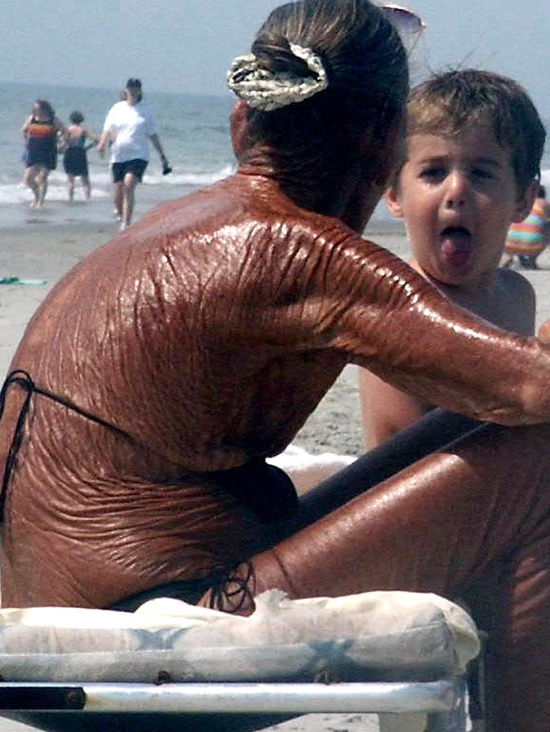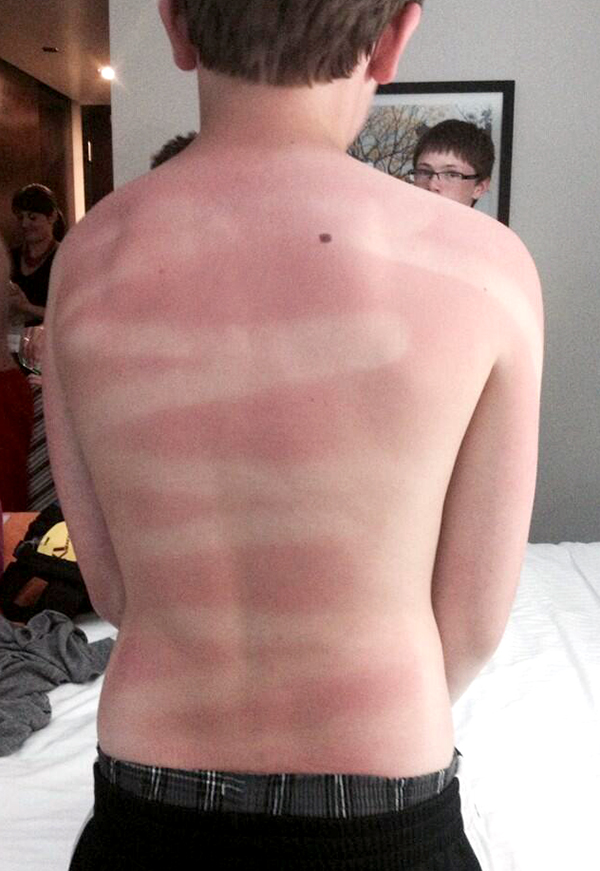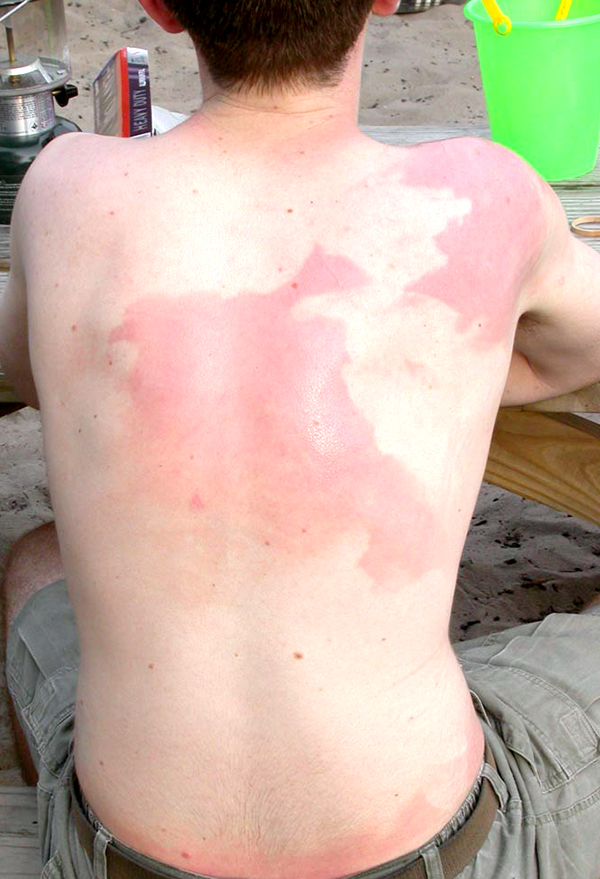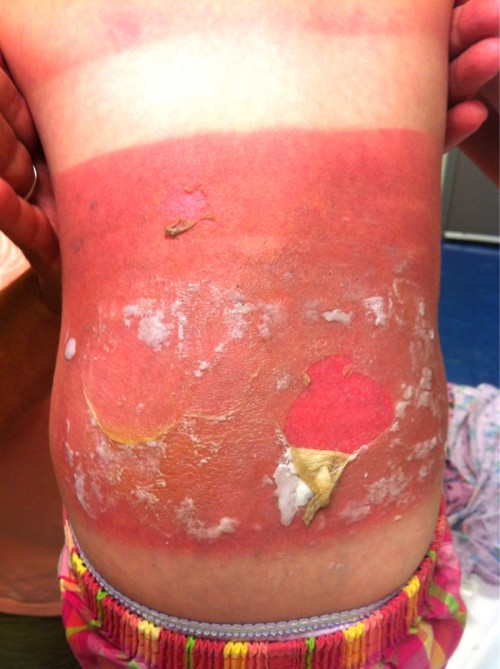Sunburn in Infants, Children and Adolescents
I have been holding off writing a summer article until the weather made it clear that it really was summer. I don’t seem to have been quick enough on the draw, however, there was no spring to warn me.
When the weather warms up we begin seeing less contagious illnesses like colds, ear infections, chicken pox, etc. (very warm areas decrease illness in summer as people go indoors for air conditioning.)
Infant with severe second degree sunburnHowever, there are some things that we see more of in the summer like sunburn; which can range from very mild and uncomfortable to severe and even deadly.
Sunburn: Causes – Complications
In this community, every spring there are one or two babies admitted to the hospital who have gone out on a sunny day and very quickly received second degree sunburns over large portions of their body.
Some can get so dehydrated from the burn that they need intravenous fluid therapy. The infant in the internet photo to the right was surely admitted to the hospital with second degree thermal burns. She, most certainly, was crying as her mother held her up for the camera.
Blisters are present into the dermis and there is evidence of topical cream used to help ameliorate the pain… somewhat. Pretty much all uncovered/unprotected skin will burn; which, in this case was abdomen, back, face, arms and legs – easily constituting the majority of total skin surface.
 Woman with severe skin damage due to chronic sun exposure
Woman with severe skin damage due to chronic sun exposureIn severe cases like this, the burn will will be painful but fluid loss (leaking out into surrounding skin due to vascular damage – “third spacing”) can be massive and even cause shock and renal failure.
Sunburn can even occur (and most frequently does) on deceptively overcast days with the sun beyond light clouds.
The problem arises, as you may be aware, from the fact that sunburns and tanning are caused by your bodies reaction to certain wave lengths of sun light (ultraviolet) which can readily penetrate clouds.
The so called "tanning centers’" take advantage of this by allowing patrons to expose themselves to ultraviolet lights during the winter and thereby get a deep suntan.
Many people feel that tan skin is more "healthy" looking. And I must confess that, intuitively, it does to me too – to a point.
However, in addition to being quite dangerous to infants, the ultraviolet light and the tanning process has recently been shown to have some undesirable affects. We have for some time been able to link certain forms of skin cancers found with increased frequency in those individuals who have a heavy sun exposure.
It also seems that there is increased skin cancer problems in individuals who are light complected, blond or have certain diseases of pigmentation. In addition, dermatologists have found that as the ultraviolet light penetrates the outer layers of the skin not only are the tanning cells stimulated but there are changes in its collagen (supporting structure) too.
The collagen becomes weakened which can result in permanent changes and premature aging. Gradually there is a wrinkling and leathering effect in addition to drying of the skin.
 Reason NOT to use sprays!
Reason NOT to use sprays!Of course the best treatment is prevention in the first place. Wearing a hat and other protective clothing helps greatly.
Sunburn: Treatment
Sunscreens have been developed which are amazingly protective in nature. These compounds usually contain Para Amino Benzoic Acid (PABA) in varying amounts. As the ultraviolet light strikes the PABA its energy is absorbed before it is able to strike the skin.
 Reason to find someone else to apply the suntan lotion
Reason to find someone else to apply the suntan lotionThe sunscreens have all been labeled with a number. The higher the number the more protection afforded. I recommend that all children with anticipated heavy sun exposure, especially fair skinned ones, be protected with a sunscreen of the highest available number.
As the summer progresses and the child gets suntanned the protection factor can be decreased. However, in light of the cancer and aging effects previously mentioned, most people should use at least some protection all of the time.
An infant with a sunburn should probably be seen by a doctor especially if he looks like he is getting "sick", has blisters forming or his urine output drops off.
Sunburns should be treated like any other mild burn. Removal of the burning source is imperative. (Get out of the sun.) Cool moist towels not only help take away some of the pain but seem to prevent the burn from deepening into the deeper tissues.
The creams which contain a local anesthetic, are a great benefit. My favorite is Nupercainal but there are others just as good containing the "cain" type of medicines and will help take away the pain.
Even mildly burned skin looses a lot of fluids which should be replaced very freely by drinking oral fluids – some of which contain light salt (like Gatorade).
Fluid drinking should continue until the individual is urinating frequently (a sign that the body has restored its fluid levels).
As the sunburn progresses to a tan and then peels, protection can be afforded by the use of Vaseline or ointments. These tend to hold in the bodies natural moisture and can prevent itching.
Advertisement by Google
(sorry, only few pages have ads)

